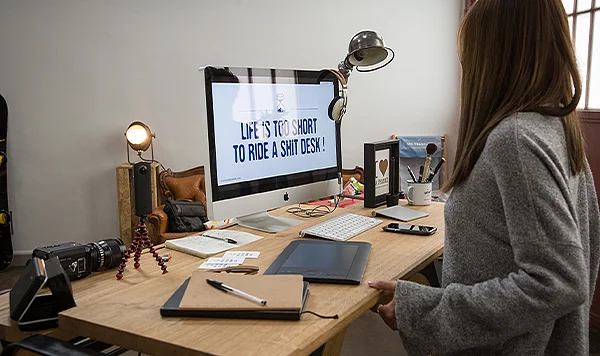The standing desk: synonymous with well-being
AT WORK


The sit-stand desk
The concept of the sit-stand desk is closely linked to workplace well-being. As a brand, we understand that the design of workspaces, including desks, is a crucial factor for employee productivity and engagement. This relationship goes beyond fleeting trends and has long intrigued design professionals and entrepreneurs seeking innovative ways to enhance productivity and foster a collaborative work environment. In practice, spatial layout, sit-stand posture options, and workstation mobility significantly impact employees’ well-being, both physically and creatively and emotionally.
Mobility within the Workspace Leads to Satisfaction and Productivity
We are convinced that mobility within the workspace is essential for promoting employee satisfaction and productivity. For many years, our teams have been focusing on this crucial issue of work and the professional environment. Our research has led us to understand how the workplace can influence individual behavior, reinforce corporate culture, and improve performance.
In a constantly evolving professional world, employee productivity and engagement are key elements of success, both economically and humanly. More and more leaders are incorporating these factors into their business strategy, recognizing that happy employees are more likely to fully invest in their work. Mobility within the workspace allows employees to “live” their workstation by offering them the necessary freedom and autonomy. This translates to the ability to work in different positions (sitting, standing, leaning), in various locations as needed. It also means being able to isolate oneself for concentration or, conversely, to foster contact with colleagues, depending on the projects and even the mood of the moment.
Redesigning the Workspace with a Human-Centered Approach
We place the human at the center of our workspace design. Employees seek inspiring environments that stimulate their creativity and technological tools that facilitate their daily tasks rather than complicating them.
Today, the quality of a well-adapted work environment reflects a company’s care for its employees. It must promote concentration and creativity while preserving intimacy and avoiding overcrowding. This means recognizing the uniqueness of each individual and tailoring the workspace to their specific needs. The rejection of standardized offices and monotonous open spaces is a thing of the past. Attracting talent today involves offering them freedom in their way of working, where autonomy replaces monotony, and flexibility breaks rigidity.
The Sit-Stand Desk and Ergonomic Seating, Creators of Workplace Well-being
We emphasize efficiency without neglecting the human aspect. Today, mobility has become a central element of workplace well-being. Our designers focus on creating sit-stand desks and ergonomic and active seating, offering various postures to counter the static nature of certain jobs.
The Will & Walt Flipboard, a desk with a vintage design and Scandinavian style, along with the accompanying Flipstool, fits into this trend of placing happiness at work at the heart of tomorrow’s professional spaces. This evolution promotes well-being, which in turn stimulates productivity and creativity. This trend is not anecdotal but a major movement in the corporate world for several decades, leading to innovative designs in sit-stand desks and seating that help prevent Musculoskeletal Disorders. Regardless of your role or field of activity, you will be prompted to reconsider your approach to workplace well-being by changing your perspective, posture, and point of view.